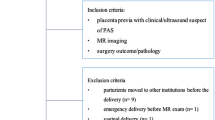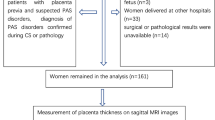Abstract
Objectives
To characterise MRI features of invasive placenta previa and to identify specific features for differentiating placenta percreta (PP) from placenta accreta (PA).
Methods
Forty-five women with PP and 93 women with PA who underwent 1.5T placental MRI were included. Two radiologists independently evaluated the MRI features of invasive placenta previa, including our novel type of placental bulge (i.e. placental bulge type-II, characterized by placental bulge with distorted uterine outline). Pearson’s chi-squared or Fisher’s two-sided exact test was performed to compare the MRI features between PP and PA. Logistic stepwise regression analysis and the area under the receiver operating characteristic curve (AUC) were performed to select the optimal features for differentiating PP from PA.
Results
Significant differences were found in nine MRI features between women with PP and those with PA (P <0.05). Placental bulge type-II and uterine serosal hypervascularity were independently associated with PP (odds ratio = 48.618, P < 0.001; odds ratio = 4.165, P = 0.018 respectively), and the combination of the two MRI features to distinguish PP from PA yielded an AUC of 0.92 for its predictive performance.
Conclusion
Placental bulge type-II and uterine serosal hypervascularity are useful MRI features for differentiating PP from PA.
Key Points
• Placental bulge type-II demonstrated the strongest independent association with PP.
• Uterine serosal hypervascularity is a useful feature for differentiating PP from PA.
• MRI features associated with abnormal vessels increase the risk of massive haemorrhage.






Similar content being viewed by others
Abbreviations
- AIP:
-
Abnormal invasive placenta
- AUC:
-
Area under the receiver operating characteristic curve
- MRI:
-
Magnetic resonance imaging
- NPV:
-
Negative predictive value
- PA:
-
Placenta accreta
- PP:
-
Placenta percreta
- PPV:
-
Positive predictive value
- ROC:
-
Receiver operating characteristic curve
- T2-Haste:
-
T2-weighted half-Fourier single-shot turbo spin echo
- T2-True FISP:
-
T2-weighted true fast imaging with steady-state precession
References
Belfort MA, S. c. f. M.-F. M. Publications Committee (2010) Placenta accreta. Am J Obstet Gynecol 203:430–439
Clark SL, Koonings PP, Phelan JP (1985) Placenta previa/accreta and prior cesarean section. Obstet Gynecol 66:89–92
Wu S, Kocherginsky M, Hibbard JU (2005) Abnormal placentation: twenty-year analysis. Am J Obstet Gynecol 192:1458–1461
Silver RM, Barbour KD (2015) Placenta accreta spectrum: accreta, increta, and percreta. Obstet Gynecol Clin North Am 42:381–402
Cunningham FG WJ (2010) Obstetrical hemorrhage. William’s obstetrics, 23rd edn. McGraw-Hill, New York, pp 776–780
Eller AG, Porter TF, Soisson P, Silver RM (2009) Optimal management strategies for placenta accreta. BJOG 116:648–654
Warshak CR, Ramos GA, Eskander R et al (2010) Effect of predelivery diagnosis in 99 consecutive cases of placenta accreta. Obstet Gynecol 115:65–69
Palacios Jaraquemada JM, Bruno CH (2005) Magnetic resonance imaging in 300 cases of placenta accreta: surgical correlation of new findings. Acta Obstet Gynecol Scand 84:716–724
Bour L, Place V, Bendavid S et al (2014) Suspected invasive placenta: evaluation with magnetic resonance imaging. Eur Radiol 24:3150–3160
Derman AY, Nikac V, Haberman S, Zelenko N, Opsha O, Flyer M (2011) MRI of placenta accreta: a new imaging perspective. AJR Am J Roentgenol 197:1514–1521
Kim JA, Narra VR (2004) Magnetic resonance imaging with true fast imaging with steady-state precession and half-Fourier acquisition single-shot turbo spin-echo sequences in cases of suspected placenta accreta. Acta Radiol 45:692–698
Lax A, Prince MR, Mennitt KW, Schwebach JR, Budorick NE (2007) The value of specific MRI features in the evaluation of suspected placental invasion. Magn Reson Imaging 25:87–93
Maldjian C, Adam R, Pelosi M, Pelosi M 3rd, Rudelli RD, Maldjian J (1999) MRI appearance of placenta percreta and placenta accreta. Magn Reson Imaging 17:965–971
Srisajjakul S, Prapaisilp P, Bangchokdee S (2014) MRI of placental adhesive disorder. Br J Radiol 87:20140294
D'Antonio F, Iacovella C, Palacios-Jaraquemada J, Bruno CH, Manzoli L, Bhide A (2014) Prenatal identification of invasive placentation using magnetic resonance imaging: systematic review and meta-analysis. Ultrasound Obstet Gynecol 44:8–16
Meng X, Xie L, Song W (2013) Comparing the diagnostic value of ultrasound and magnetic resonance imaging for placenta accreta: a systematic review and meta-analysis. Ultrasound Med Biol 39:1958–1965
Masselli G, Brunelli R, Casciani E et al (2008) Magnetic resonance imaging in the evaluation of placental adhesive disorders: correlation with color Doppler ultrasound. Eur Radiol 18:1292–1299
Warshak CR, Eskander R, Hull AD et al (2006) Accuracy of ultrasonography and magnetic resonance imaging in the diagnosis of placenta accreta. Obstet Gynecol 108:573–581
Leyendecker JR, DuBose M, Hosseinzadeh K et al (2012) MRI of pregnancy-related issues: abnormal placentation. AJR Am J Roentgenol 198:311–320
Baughman WC, Corteville JE, Shah RR (2008) Placenta accreta: spectrum of US and MR imaging findings. Radiographics 28:1905–1916
Millischer AE, Salomon LJ, Porcher R, et al. (2016) Magnetic resonance imaging for abnormally invasive placenta: the added value of intravenous gadolinium injection. BJOG
Blaicher W, Brugger PC, Mittermayer C et al (2006) Magnetic resonance imaging of the normal placenta. Eur J Radiol 57:256–260
Rahaim NS, Whitby EH (2015) The MRI features of placental adhesion disorder and their diagnostic significance: systematic review. Clin Radiol 70:917–925
Cuthbert F, Teixidor Vinas M, Whitby E (2016) The MRI features of placental adhesion disorder–a pictorial review. Br J Radiol 89:20160284
Thiravit S, Lapatikarn S, Muangsomboon K, Suvannarerg V, Thiravit P, Korpraphong P (2016) MRI of placenta percreta: differentiation from other entities of placental adhesive disorder. Radiol Med
Kilcoyne A, Shenoy-Bhangle AS, Roberts DJ, Sisodia RC, Gervais DA, Lee SI (2016) MRI of placenta accreta, placenta increta, and placenta percreta: pearls and pitfalls. AJR Am J Roentgenol 20:1–8
Cali G, Giambanco L, Puccio G, Forlani F (2013) Morbidly adherent placenta: evaluation of ultrasound diagnostic criteria and differentiation of placenta accreta from percreta. Ultrasound Obstet Gynecol 41:406–412
Jauniaux E, Collins SL, Jurkovic D, Burton GJ (2016) Accreta placentation: a systematic review of prenatal ultrasound imaging and grading of villous invasiveness. Am J Obstet Gynecol
Rac MW, Dashe JS, Wells CE, Moschos E, McIntire DD, Twickler DM (2015) Ultrasound predictors of placental invasion: the Placenta Accreta Index. Am J Obstet Gynecol 212:343 e341–347
Chantraine F, Blacher S, Berndt S et al (2012) Abnormal vascular architecture at the placental-maternal interface in placenta increta. Am J Obstet Gynecol 207:188 e181–189
Alamo L, Anaye A, Rey J et al (2013) Detection of suspected placental invasion by MRI: do the results depend on observer' experience? Eur J Radiol 82:e51–e57
Levine D, Hulka CA, Ludmir J, Li W, Edelman RR (1997) Placenta accreta: evaluation with color Doppler US, power Doppler US, and MR imaging. Radiology 205:773–776
Palacios Jaraquemada JM, Bruno C (2000) Gadolinium-enhanced MR imaging in the differential diagnosis of placenta accreta and placenta percreta. Radiology 216:610–611
Tanaka YO, Sohda S, Shigemitsu S, Niitsu M, Itai Y (2001) High temporal resolution dynamic contrast MRI in a high risk group for placenta accreta. Magn Reson Imaging 19:635–642
Ray JG, Vermeulen MJ, Bharatha A et al (2016) Association between MRI exposure during pregnancy and fetal and childhood outcomes. JAMA 316:952–961
Author information
Authors and Affiliations
Corresponding author
Ethics declarations
Guarantor
The scientific guarantor of this publication is Guangbin Wang.
Conflict of interest
The authors of this manuscript declare no relationships with any companies whose products or services may be related to the subject matter of the article.
Funding
This work was supported by the National Natural Science Foundation of China under Grant No. 81371534, 81171380.
Statistics and biometry
No complex statistical methods were necessary for this paper.
Ethical approval
Institutional Review Board approval was obtained.
Informed consent
Written informed consent was waived in this retrospective study.
Methodology
• retrospective
• comparative study
• performed at one institution
Rights and permissions
About this article
Cite this article
Chen, X., Shan, R., Zhao, L. et al. Invasive placenta previa: Placental bulge with distorted uterine outline and uterine serosal hypervascularity at 1.5T MRI – useful features for differentiating placenta percreta from placenta accreta. Eur Radiol 28, 708–717 (2018). https://doi.org/10.1007/s00330-017-4980-z
Received:
Revised:
Accepted:
Published:
Issue Date:
DOI: https://doi.org/10.1007/s00330-017-4980-z




